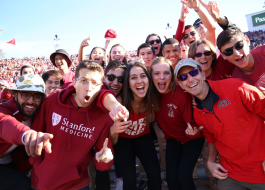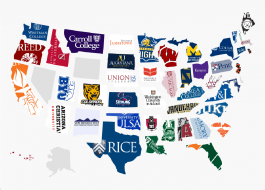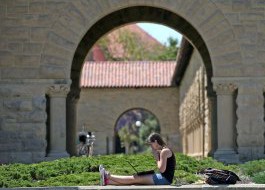If it seems like gaining acceptance into selective colleges seems harder today than a decade ago, that's because it is. And at a dizzying pace.
Harvard and Stanford reject nearly 95% of the students who apply.
But that wasn't the case two decades ago when the acceptance rate at both schools was in the double digits. For the class of 2001 (meaning students were accepted in 1997) the admission rate at Stanford was 15.5% and the rate at Harvard was 12.3%.
 Business Insider / Mike Nudelman
Business Insider / Mike Nudelman
Some experts believe the competition is driven by the so-called admissions arms race, in which colleges are incentivized to push acceptance rates lower which in turn helps their US News & World ranking.
But the steady uptick of college applicants, especially at elite schools is stark, in part due to the emergence of Common App, which allows students to apply to many schools at once.
"Admissions have gotten more and more competitive in the past decade," Angela Dunnham, a college admissions counselor at InGenius Prep and former assistant director of admissions at Dartmouth College, told Business Insider. "In addition to the sheer number of applicants applying, the expectations for candidates have increased."
 Harvard students Adam Glanzman/Getty Images
Harvard students Adam Glanzman/Getty Images
On top of more domestic applicants, international students have begun to flood US college admissions.
"I met a Korean freshman who scored a 2400/2400 on the SAT, after taking it once," Dunnham said. "She also was conducting impressive research and loved debate."
However, there may be reason to view this lowering acceptance rate with some skepticism, Cat McManus, a counselor InGenius Prep and a former assistant dean and regional director at the University of Pennsylvania, told Business Insider.
Selective colleges may have ballpark figures they hope to achieve (and not surpass) when it comes to the percentage of an incoming class that can be comprised of international students, McManus explained. The increase in international applicants, therefore, while it may drive down the overall acceptance rate, likely has less impact on US applicants than is sometimes believed.
"The rise in the number of international applicants to the most selective institutions in the US has inflated the number of overall applicants, as well as, in some cases, the GPA and testing profiles, which makes schools appear more selective from a purely statistical standpoint," McManus, who was also an admissions officer at Princeton, said.
And while in many cases it looks like GPA and standardized test score averages are increasing, some of this should be attributed to the test prep era, which is ubiquitous in the college admissions process.
"Whether applicants are actually 'stronger' is tough to say," McManus said. "There is also a lot of essay 'help' that goes on, both domestically and internationally."
Still, while the increase in students utilizing test prep to boost scores doesn't necessarily mean these applicants are inherently stronger students than they were a decade ago, it does mean that average test scores are inching up, potentially harming students who don't have the means to pay for extra help.




